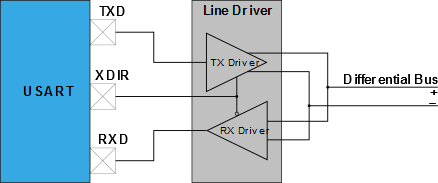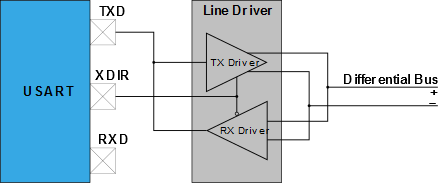RS-485 is a communication standard supported by the USART peripheral. It is a physical interface that defines the setup of a communication circuit. Data are transmitted using differential signaling, making communication robust against noise. RS-485 is enabled by writing to the RS485 bit field in the USARTn.CTRLA register.
The RS-485 mode supports external line
driver devices that convert a single USART transmission into corresponding differential
pair signals. Writing RS485[0] to ‘1’ enables the automatic control of the
XDIR pin that can be used to enable transmission or reception for the line driver device.
The USART automatically drives the XDIR pin high while the USART is transmitting and pulls
it low when the transmission is complete. An example of such a circuit is shown in the
figure below.


Writing RS485[1] to ‘1’ enables the RS-485 mode, which automatically sets
the TXD pin to output one clock cycle before starting transmission and sets it back to
input when the transmission is complete.
RS-485 mode is compatible with One-Wire mode. One-Wire mode enables an internal connection between the TXD pin and the USART receiver, making the TXD pin a combined TxD/RxD line. The RXD pin will be disconnected from the USART receiver and may be controlled by a different peripheral. An example of such a circuit is shown in the figure below.
